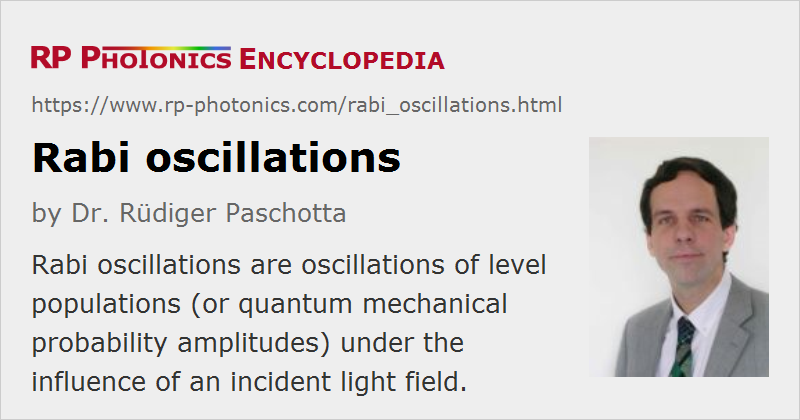Rabi Oscillations
Definition: oscillations of level populations (or quantum mechanical probability amplitudes) under the influence of an incident light field
German: Rabi-Oszillationen
Categories: quantum optics, physical foundations
How to cite the article; suggest additional literature
Author: Dr. Rüdiger Paschotta
If light interacts with a two-level system (e.g. an atom or ion with a ground state and an excited state), this can lead to a periodic exchange of energy between the light field and the two-level system. Such oscillations, which are called Rabi oscillations (with reference to the Nobel Prize winner Isidor Isaac Rabi), are associated with oscillations of the quantum mechanical expectation values of level populations and photon numbers. They can be interpreted as a periodic change between absorption and stimulated emission of photons, and can be modeled using the Bloch vector formalism. A competing process, which can prevent these oscillations, is spontaneous emission.
The angular frequency of the Rabi oscillations (2π times the number of Rabi cycles per second) is called the Rabi frequency. It is proportional to the amplitude (not the optical intensity) of the light field and to the dipole moment of the level transition.
When a solid-state gain medium is optically pumped, Rabi oscillations usually cannot be observed, since the upper and lower states actually consist of Stark level manifolds (containing multiple sub-levels) and coherence is quickly destroyed by phonons. Further, inhomogeneous broadening may occur, and the optical intensities are usually not spatially uniform.
Questions and Comments from Users
Here you can submit questions and comments. As far as they get accepted by the author, they will appear above this paragraph together with the author’s answer. The author will decide on acceptance based on certain criteria. Essentially, the issue must be of sufficiently broad interest.
Please do not enter personal data here; we would otherwise delete it soon. (See also our privacy declaration.) If you wish to receive personal feedback or consultancy from the author, please contact him e.g. via e-mail.
By submitting the information, you give your consent to the potential publication of your inputs on our website according to our rules. (If you later retract your consent, we will delete those inputs.) As your inputs are first reviewed by the author, they may be published with some delay.
See also: quantum optics, gain media, coherence, optical pumping
and other articles in the categories quantum optics, physical foundations
 |



If you like this page, please share the link with your friends and colleagues, e.g. via social media:
These sharing buttons are implemented in a privacy-friendly way!